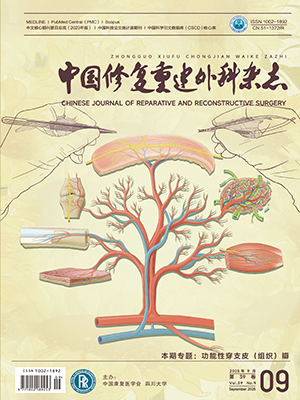| 1. |
Bragdon CR, Jasty M, Muratoglu OK, et al. Third-body wear testing of a highly cross-linked acetabular liner:the effect of large femoral head size in the presence of particulate poly(methylmethacrylate)debris. J Arthroplasty, 2005, 20(3):379-385.
|
| 2. |
Heiner AD, Galvin AL, Fisher J, et al. Scratching vulnerability of conventional vs highly cross-linked polyethylene liners because of large embedded third-body particles. J Arthroplasty, 2012, 27(5):742-749.
|
| 3. |
Hammerberg EM, Wan Z, Dastane M, et al. Wear and range of motion of different femoral head sizes. J Arthroplasty, 2010, 25(6):839-843.
|
| 4. |
Geller JA, Malchau H, Bragdon C, et al. Large diameter femoral heads on highly cross-l inked polyethylene. Cl in Orthop Relat Res, 2006, (447):53-59.
|
| 5. |
Lachiewicz PF, Soileau ES. Dislocation of primary total hip arthroplasty with 36 and 40 mm femoral heads. Clin Orthop Relat Res, 2006, (453):153-155.
|
| 6. |
Harris WH, Muratoglu OK. A review of current cross-linked polyethylenes used in total joint arthroplasty. Clin Orthop Relat Res, 2005, (430):46-52.
|
| 7. |
戴雪松, 严世贵, 潘志军, 等.全髋关节置换术后聚乙烯内衬磨损的测量及其临床意义.中华骨科杂志, 2001, 21(4):229-232.
|
| 8. |
Martell JM, Berdia S. Determination of polyethylene wear in total hip replacements with use of digital radiographs. J Bone Joint Surg (Am), 1997, 79(11):1635-1641.
|
| 9. |
魏召劝, 孙俊英, 查国春, 等.采用高交联聚乙烯与传统聚乙烯髋臼内衬行人工全髋关节置换的比较研究.中国修复重建外科杂志, 2013, 27(12):1414-1418.
|
| 10. |
Wroblewski BM, Siney PD, Fleming PA. Low-friction arthroplasty of the hip using alumina ceramic and cross-linked polyethylene. J Bone Joint Surg (Br), 1999, 81(1):54-55.
|
| 11. |
Burroughs BR, Hallstrom B, Golladay GJ, et al. Range of motion and stabil ity in total hip arthroplasty with 28-, 32-, 38-, and 44-mm femoral head sizes. J Arthroplasty, 2005, 20(1):11-19.
|
| 12. |
Martell JM, Verner JJ, Incavo SJ. Cl inical performance of ahighly cross-linked polyethylene at two years in total hip arthroplasty:a randomized prospective trial. J Arthroplasty, 2003, 18(7 Suppl 1):55-59.
|
| 13. |
DeLee JG, Charnley J. Radiological demarcation of cemented sockets in total hip replacement. Clin Orthop Relat Res, 1976, (121):20-32.
|
| 14. |
Hui AJ, McCalden RW, Martell JM, et al. Validation of two and threedimensional radiographic techniques for measuring polyethylene wear after total hip arthroplasty. J Bone Joint Surg (Am), 2003, 85-A(3): 505-511.
|
| 15. |
Zicat B, Engh CA, Gokcen E. Patterns of osteolysis around total hip components inserted with and without cement. J Bone Joint Surg (Am), 1995, 77(3):432-439.
|
| 16. |
Latimer HA, Lachiewicz PF. Porous-coated acetabular components with screw fixation. Five to ten-year results. J Bone Joint Surg (Am), 1996, 78(7):975-981.
|
| 17. |
D'Antonio JA, Capello WN, Manley MT. Remodeling of bone around hydroxyapatite-coated femoral stems. J Bone Joint Surg (Am), 1996, 78(8):1226-1234.
|
| 18. |
Kawamura H, Dunbar MJ, Murray P, et al. The porous coated anatomic total hip replacement. A ten to fourteen-year follow-up study of a cementless total hip arthroplasty. J Bone Joint Surg (Am), 2001, 83(9):1333-1338.
|
| 19. |
Engh CA Jr, Culpepper WJ 2nd, Engh CA. Long-term results of use of the anatomic medullary locking prosthesis in total hip arthroplasty. J Bone Joint Surg (Am), 1997, 79(2):177-184.
|
| 20. |
Harris WH, McGann WA. Loosening of the femoral component after use of the medullary-plug cementing technique. Follow-up note with a minimum five-year follow-up. J Bone Joint Surg (Am), 1986, 68(7): 1064-1066.
|
| 21. |
黄晓楠, 张勇, 王奇.第三代陶瓷关节假体人工全髋关节置换术中长期疗效观察.中国修复重建外科杂志, 2014, 28(6):669-672.
|
| 22. |
Livermore J, Ilstrup D, Morrey B. Effect of femoral head size on wear of the polyethylene acetabular component. J Bone Joint Surg (Am), 1990, 72(4):518-528.
|
| 23. |
Dorr LD, Wan Z, Shahrdar C, et al. Clinical performance of a Durasul highly cross-linked polyethylene acetabular liner for total hip arthroplasty at five years. J Bone Joint Surg (Am), 2005, 87(8):1816-1821.
|
| 24. |
D'Antonio JA, Capello WN, Ramakrishnan R. Second-generation annealed highly cross-linked polyethylene exhibits low wear. Clin Orthop Relat Res, 2012, 470(6):1696-1704.
|
| 25. |
Ranawat AS, Tsail is P, Meftah M, et al. Minimum 5-year wear analysis of first-generation highly cross-linked polyethylene in patients 65 years and younger. J Arthroplasty, 2012, 27(3):354-357.
|
| 26. |
Muratoglu OK, Bragdon CR, O'Connor D, et al. A novel method of cross-l inking ultra-high-weight-molecular weight polyethylene to improve wear, reduce oxidation, and retain mechanical properties. Reci pient of the 1999 HAP Paul Award. J Arthroplasty, 2001, 16(2):149-160.
|
| 27. |
Muratoglu OK, Bragdon CR, O'Connor D, et al. Larger diameter femoral heads used in conjunction with a highly cross-linked ultra-high molecular weight polyethylene:a new concept. J Arthroplasty, 2001, 16(8 Suppl 1):24-30.
|
| 28. |
Bragdon CR, Jasty M, Muratoglu OK, et al Third-body wear of highly cross-l inked polyethylene in a hip simulator. J Arthroplasty, 2003, 18(5):553-561.
|
| 29. |
Digas G, Kärrholm J, Thanner J, et al. 5-year experience of highly cross-linked polyethylene in cemented and uncemented sockets:two randomized studies using radiostereometric analysis. Acta Orthop, 2007, 78(6):746-754.
|
| 30. |
Bragdon CR, Greene ME, Freiberg AA, et al. Radiostereometric analysis comparison of wear of highly cross-linked polyethylene against 36-vs 28-mm femoral heads. J Arthroplasty, 2007, 22(6 Suppl 2):125-129.
|
| 31. |
Geller JA, Malchau H, Bragdon C, et al. Large diameter femoral heads on highly cross-linked polyethylene. Clin Orthop Relat Res, 2006, 447: 53-59.
|
| 32. |
Hammerberg EM, Wan Z, Dastane M, et al. Wear and range of motion of different femoral head sizes. J Arthroplasty, 2010, 25(6):839-843.
|




